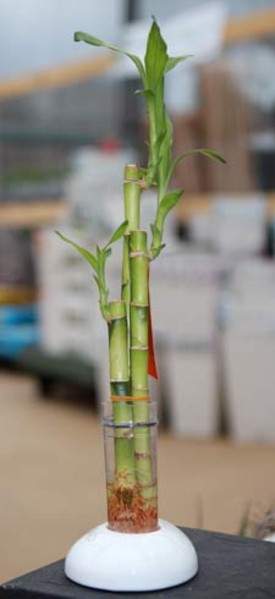 When some folks think of hydroponics, they may think of elaborate equipment or a complicated, futuristic method of cultivating indoor houseplants. The truth is, hydroponics (also known as hydroculture) is simply a method of growing indoor plants and flowers without the use of soil and can actually be a viable alternative for those not endowed with a green thumb. Unlike outdoor greenery that requires soil to live and grow, indoor plants need only water, oxygen, sunlight and basic nutrients – all things that can be provided without using traditional potting methods.
When some folks think of hydroponics, they may think of elaborate equipment or a complicated, futuristic method of cultivating indoor houseplants. The truth is, hydroponics (also known as hydroculture) is simply a method of growing indoor plants and flowers without the use of soil and can actually be a viable alternative for those not endowed with a green thumb. Unlike outdoor greenery that requires soil to live and grow, indoor plants need only water, oxygen, sunlight and basic nutrients – all things that can be provided without using traditional potting methods.
One of the most challenging aspects of growing healthy, vibrant houseplants is maintaining the precise balance of moisture. The composition and density of the soil, the rate of growth and the type of container used all play a role in determining how much water and nutrition the plant is able to utilize. By eliminating the use of soil, one can better see how much water is being absorbed and without the restriction, the more life-sustaining light and oxygen can reach the vital roots. And, perhaps most importantly, the risk of having to deal with soil-born diseases and pests is no longer an issue. So, if you decide to try growing the hydroponic way, can you simply ditch all the dirt and change all of your houseplants over to water containers? In some cases, yes, but there are a variety of factors to consider.
One thing right out of the gate, is that herbs are the best candidates for hydroponic growing. Some grow faster than others and some last longer than others, but it is very difficult to go wrong with growing any herb in water. The second most agreeable condition for successful hydroponic growing, is to use plants that were originally rooted in water. For a variety of reasons, roots that began their development in soil are not as likely to take to hydroponics, so either start from fresh clippings, or choose existing houseplants that were originally cultivated in water.
It is generally accepted among experts that there are groups of houseplants that thrive better than others in water-only environments, and these include any type of ivy, philodendron, tuberous perennial plants like begonia and as mentioned above, herbs. However, any houseplant can be grown hydroponically so long as their specific conditions are met.
Any type of container is fine for cultivating hydroponic plants, but glass is always fun because you can watch the growth process as it happens – it also allows more sunlight to reach the roots. If you are using glass, take care to be sensitive to intense light while infant roots are growing or if you are transferring plants that are accustomed to the comfort and protection of soil. If you are starting with a brand-new clipping that has no roots, or very delicate roots, it is essential that the base of the stem is not sitting on the bottom of the container. One helpful hint is to use a cardboard disc at the top of the container with holes cut out to suspend the sprig in water. The disc is also useful in keeping sunlight on the roots to a minimum.
There is a whole host of nutrient solutions available for hydroponic growing and these can be found on the internet or at your local home and garden supply. Many experts recommend using only clean, filtered water to begin the propagation process and to add nutrients only after several weeks. This will depend on the strength and maturity of the plants you are converting, but generally speaking most solutions are too rich for infant plants.
While the water in your containers will need to be replenished at least every few weeks because of evaporation, it rarely, if ever needs to be changed. Unlike the stagnant water we encounter with cut flowers, living plants are not decomposing and know how to use whatever nutrients are available. If your house happens to be excessively dusty or your plants are city dwellers living in windows that are in the direct line of car exhaust, it may be best to place fine mesh over the mouth of the container to keep pollutants to a minimum. Constantly changing hydroponic water can disrupt the natural environment your plants have worked hard to create.
Converting houseplants to hydroponics is a fun, engaging way to cultivate your indoor garden and a great way to keep maintenance and problems to a minimum. Having open water containers all about your home is also an excellent way to add moisture and humidity to your indoor air, so give it a go and let us know how it goes!
Credit: Renovateyourworld.com




























